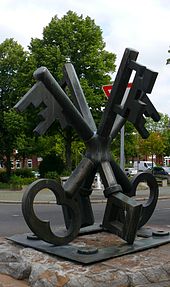Key monument
The key monument , also key monument , engl. Crossed Keys Sculpture , is a memorial in the East Westphalian city of Lübbecke in the Minden-Lübbecke district in North Rhine-Westphalia .
The memorial is a reminder of the decades of stationing British forces on the city's territory after World War II . The bronze sculpture on the plinth represents four oversized keys , each of which is either crossed in pairs at right angles to its flat sides, or by inclining its long sides (hereinafter referred to as styles ). Two have a square grip hole. These stand for Lübbecke, with the other two, those stand for the British, it consists of second overlapping circles. The beards of the keys are roughly jagged in the old style with rectangular edges. The style of the key has a round cross-section. At the intersection, however, this is raised and rounded and all styles interpenetrate in this area. The symbol was chosen because both Lübbecke and the British armored division have crossed keys in their arms. In 2017, the monument was given a new base as part of the renovation of the Lübbeck city center. It is (e) an 11.7 ton rock block made of Piesberg sandstone .
background
On April 3, 1945, Lübbecke was occupied by British troops without major resistance. The nearby Bad Oeynhausen became the headquarters of the British occupiers and Lübbecke also housed British administrative bodies and military staff units. For this purpose, 251 of 432 houses in Lübbecke were confiscated and sealed off as living space for the Allies. In addition, almost the entire inner city became an extra-territorial zone, because all the main administrative buildings of the urban infrastructure went to the British. The tax office on Kaiserstraße was chosen as the seat of the British zone administration. Even after the founding of the Federal Republic of Germany, this building remained the seat of British military staff, most recently the divisional staff of the 2nd Division, and most recently the headquarters of the 2nd British Armored Division, which withdrew in 1983. The key monument on the Gänsemarkt commemorates “the stay of the headquarters of the 2nd British Armored Division in Lübbecke 1958 - 1982. ... The 2nd Armored Division and the city of Lübbecke have crossed keys as emblems. The double crossed keys of the sculpture symbolize the close friendship that existed between the headquarters and the city during this period. "
The British 2nd Division was initially merged with the 36th Division and built in February 1947 in St. David's Barracks in Hilden, Germany. It was then merged with the disbanded 6th Panzer Division in 1958 and then moved (completed in September 1959) to Lübbecke in the Tunis Barracks in Lübbecke. In the early 1970s it consisted of the 4th Armored Brigade and the 12th Mechanized Brigade, but in 1976 the 2nd Division was reorganized into the 2nd Armored Division. The farewell parade on the market square in Lübbecke took place on November 12, 1982 in the presence of the mayor. At the end (as of 1976) the division comprised 8,500 active soldiers, of which only a small part (including the division staff in the old tax office, a telecommunications battalion in the Tunis Barracks) was stationed in Lübbecke.
Individual evidence
- ^ Article in the Neue Westfälische
- ^ Page of the British SK in Germany with pictures
- ↑ Inscription on the key monument
- ↑ Article in Hallo Lübbecke from February 2, 2017


